From Hunting-Gathering to Growing Food
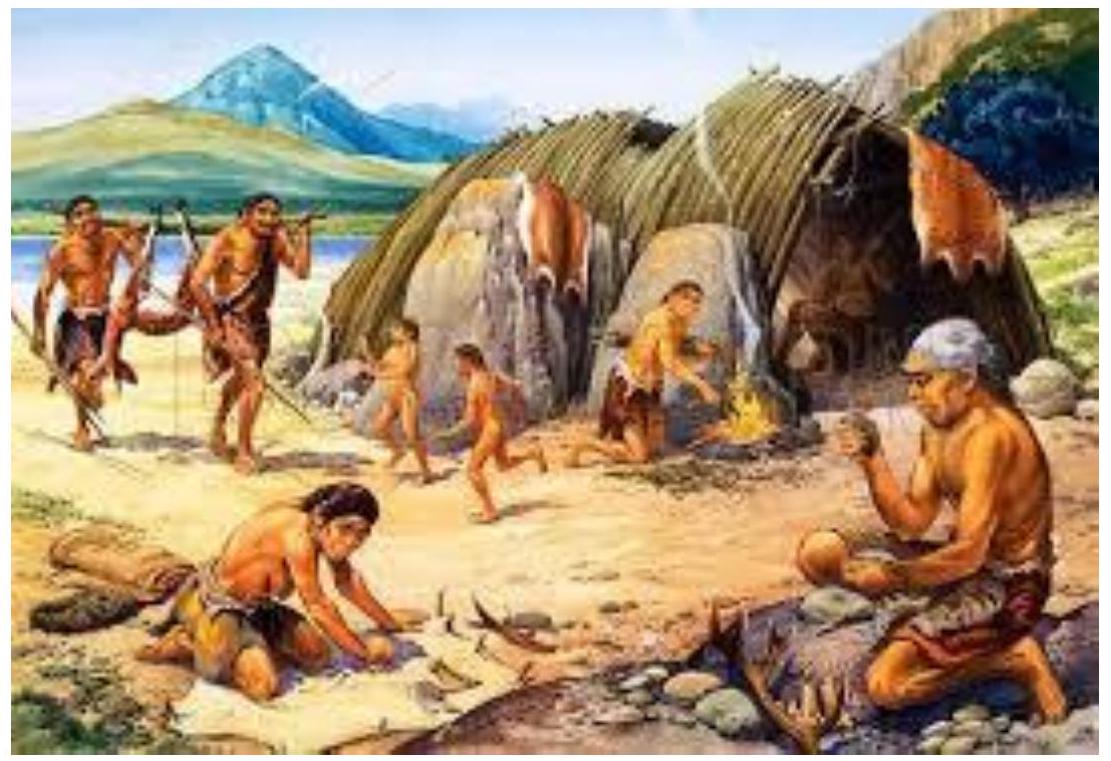
"The Stone Age began about 2.6 million years ago, when researchers found the earliest evidence of humans using stone tools, and lasted until about 3,300 B.C. when the Bronze Age began."
The earliest people
- We know about people who lived in the subcontinent as early as two million years ago. Today, we describe them as hunter-gatherers. The name comes from the way in which they got their food. Generally, they hunted wild animals, caught fish and birds, gathered fruits, roots, nuts, seeds, leaves, stalks and eggs.
1.0Hunter-gatherers moved from place to place
There are many reasons for this
- First, if they had stayed at one place for a long time, they would have eaten up all the available plant and animal resources. Therefore, they would have had to go elsewhere in search of food.
- Second, animals move from place to place - either in search of smaller prey, or, in the case of deer and wild cattle, in search of grass and leaves. That is why those who hunted them had to follow their movements.
- Third, plants and trees bear fruit in different seasons. So, people may have moved from season to season in search of different kinds of plants.
- Fourth, people, plants and animals need water to survive. Water is found in lakes, streams and rivers. While many rivers and lakes are perennial (with water throughout the year) others are seasonal. People living on their banks would have had to go in search of water during the dry seasons (winter and summer).
2.0How do we know about these people?
- Archaeologists have found some of the things hunter-gatherers made and used.
- It is likely that people made and used tools of stone, wood and bone, of which stone tools have survived best.
- Some of these stone tools were used to cut meat and bone, scrape bark (from trees) and hides (animal skins), chop fruit and roots.
- Some may have been attached to handles of bone or wood, to make spears and arrows for hunting.
- Other tools were used to chop wood, which was used as firewood. Wood was also used to make huts and tools.
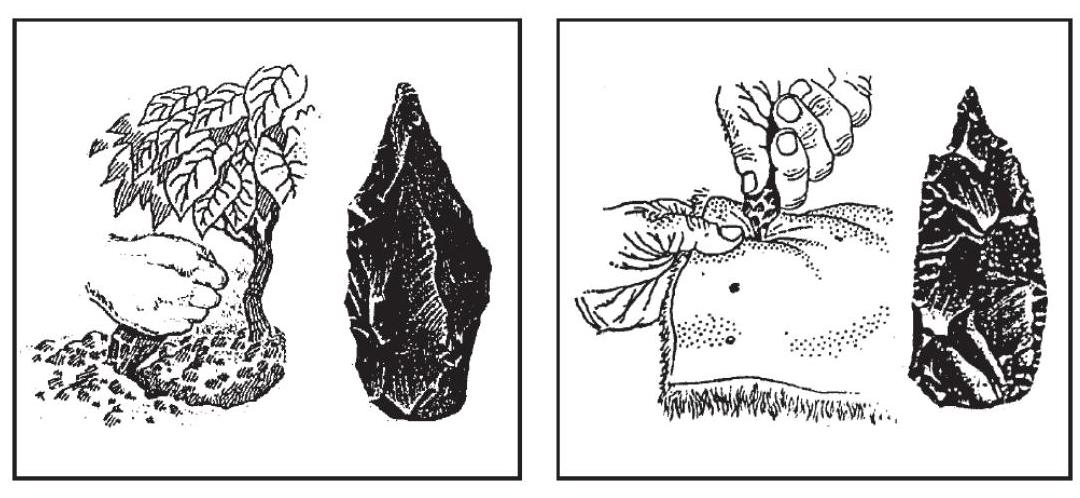
Choosing a place to live in
- Look at Map-1. All the places marked with red triangles are sites from which archaeologists have found evidence of hunter-gatherers.
- Many sites were located near rivers and lakes.
- As stone tools were important, people tried to find places where good quality stone was easily available.
Rock paintings and what they tell us -

Bhimbetka (in present day Madhya Pradesh). This is an old site with caves and rock shelters. People chose these natural caves because they provided shelter from the rain, heat and wind. These rock shelters are close to the Narmada valley.
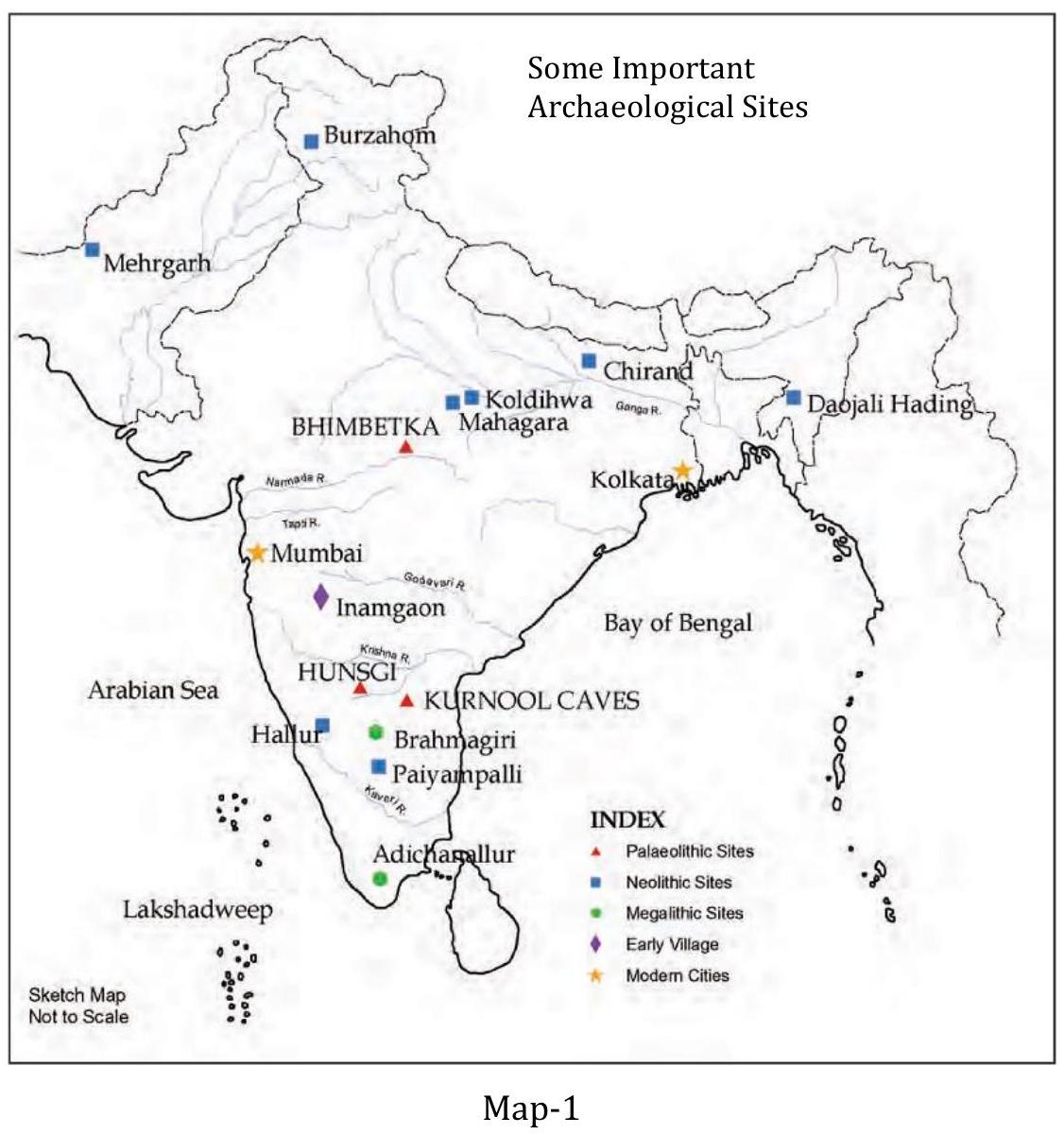
Sites
- Sites are places where the remains of things (tools, pots, buildings etc.) were found. These were made, used and left behind by people.
- These may be found on the surface of the earth, buried under the earth, or sometimes even under water.
Finding out about fire
Let's talk about Kurnool caves
- Traces of ash have been found here. This suggests that people were familiar with the use of fire.
- Fire could have been used for many things: as a source of light, to roast meat, and to scare away animals.
Names and dates
- Archaeologists have given lengthy names for the time that we are studying.
- They call the earliest period the Palaeolithic. This comes from two Greek words, 'palaeo', meaning old, and 'lithos', meaning stone. The name points to the importance of finds of stone tools. The Palaeolithic period extends from 2 million years ago to about 12,000 years ago. This long stretch of time is divided into the Lower, Middle and Upper Palaeolithic. This long span of time covers 99% of human history.
- The period when we find environmental changes, beginning about 12,000 years ago till about 10,000 years ago is called the Mesolithic (middle stone). Stone tools found during this period are generally tiny, and are called microliths. Microliths were probably stuck on to handles of bone or wood to make tools such as saws and sickles. At the same time, older varieties of tools continued to be in use.
- The next stage, from about 10,000 years ago, is known as the Neolithic.
3.0A Changing Environment
- Around 12,000 years ago, there were major changes in the climate of the world, with a shift to relatively warm conditions.
- In many areas, this led to the development of grasslands.
- This in turn led to an increase in the number of deer, antelope, goat, sheep and cattle, i.e, animals that survived on grass.
- Those who hunted these animals now followed them, learning about their food habits and their breeding seasons.
- It is likely that this helped people to start thinking about herding and rearing these animals themselves.
- Fishing also became important.
The beginning of farming and herding
- This was also a time when several grain bearing grasses, including wheat, barley and rice grew naturally in different parts of the subcontinent.
- Men, women and children probably collected these grains as food, and learnt where they grew, and when they ripened.
- This may have led them to think about growing plants on their own. In this way people became farmers.
- People could also attract and then tame animals by leaving food for them near their shelters.
- The first animal to be tamed was the wild ancestor of the dog.
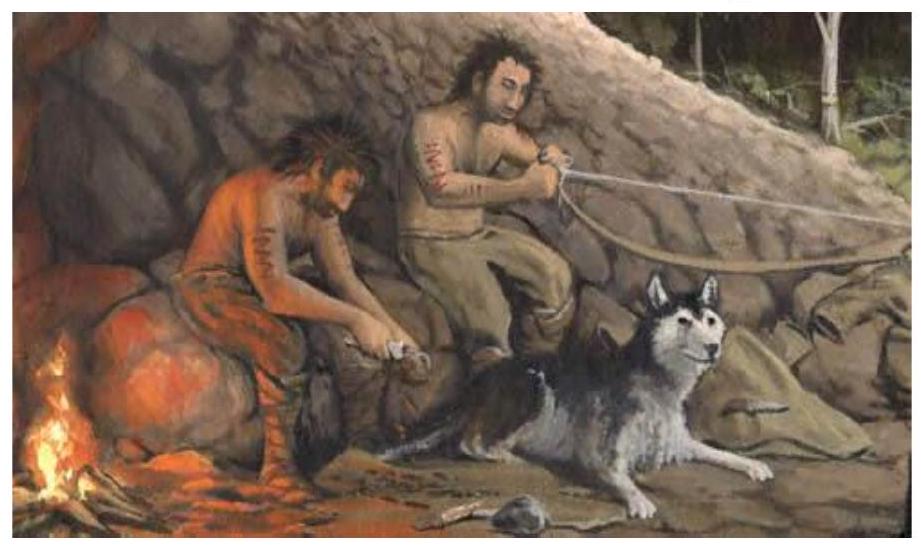
- Later, people encouraged animals that were relatively gentle to come near the camps where they lived.
- These animals such as sheep, goat, cattle and also the pig lived in herds, and most of them ate grass.
- Often, people protected these animals from attacks by other wild animals. This is how they became herders.
Domestication
- Domestication is the name given to the process in which people grow plants and look after animals.
- People select those plants and animals that are not prone to disease.
- They also select plants that yield large-size grain, and have strong stalks, capable of bearing the weight of the ripe grain.
- Seeds from selected plants are preserved and sown to ensure that new plants (and seeds) will have the same qualities.
- Amongst animals, those that are relatively gentle are selected for breeding.
- As a result, gradually, domesticated animals and plants become different from wild animals and plants.
- For example, the teeth and horns of wild animals are usually much larger than those of domesticated animals.
- Domestication was a gradual process that took place in many parts of the world. It began about 12,000 years ago.
- Virtually all the plant and animal produce that we use as food today is a result of domestication.
- Some of the earliest plants to be domesticated were wheat and barley. The earliest domesticated animals include sheep and goat.
4.0A New Way of Life
- When people began growing plants, it meant that they had to stay in the same place for a long time looking after the plants, watering, weeding, driving away animals and birds - till the grain ripened. And then, the grain had to be used carefully.
- As grain had to be stored for both food and seed, people had to think of ways of storing it.
- In many areas, they began making large clay pots, or wove baskets, or dug pits into the ground.
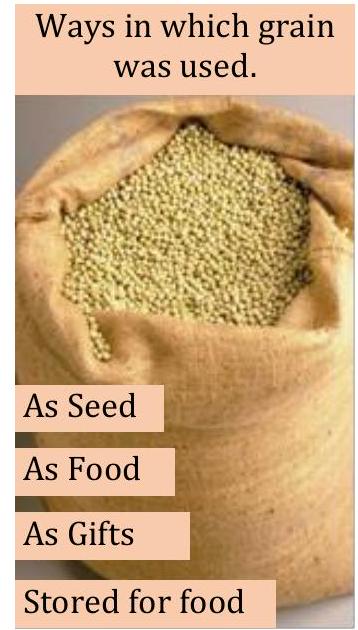
Rearing Animals
- Animals multiply naturally. Besides, if they are looked after carefully, they provide milk, which is an important source of food, and meat, whenever required.
- In other words, animals that are reared can be used as a 'store' of food.
Finding out about the first farmers and herders
- Look at the same Map. You will notice a number of blue squares. Each marks a site from where archaeologists have found evidence of early farmers and herders.
- These are found all over the subcontinent. Some of the most important ones are in the north-west, in present-day Kashmir, and in east and south India.
- To find out whether these sites were settlements of farmers and herders, scientists study evidence of plants and animal bones.
- One of the most exciting finds includes remains of burnt grain. (These may have been burnt accidentally or on purpose).
- Scientists can identify these grains, and so we know that a number of crops were grown in different parts of the subcontinent.
- They can also identify the bones of different animals.
5.0Towards a settled life
- Archaeologists have found traces of huts or houses at some sites. For instance, in Burzahom (in present-day Kashmir) people built pit-houses, which were dug into the ground, with steps leading into them. These may have provided shelter in cold weather.
- Archaeologists have also found cooking hearths both inside and outside the huts, which suggests that, depending on the weather, people could cook food either indoors or outdoors.
- Stone tools have been found from many sites as well.
- Many of these are different from the earlier Palaeolithic tools and that is why they are called Neolithic.
- These include tools that were polished to give a fine cutting edge, and mortars and pestles used for grinding grain and other plant produce.
- Mortars and pestles are used for grinding grain even today, several thousand years later.
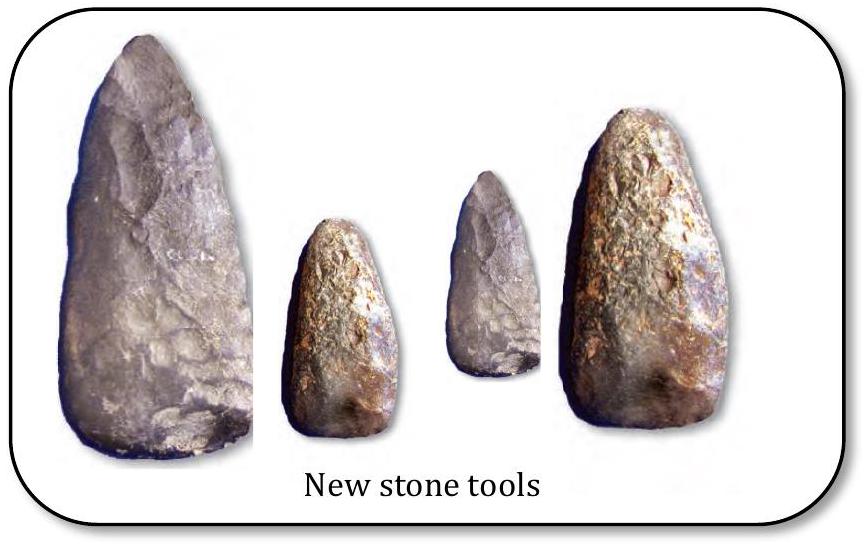
- At the same time, tools of the Palaeolithic types continued to be made and used, and remember, some tools were also made of bone.
- Many kinds of earthen pots have also been found. These were sometimes decorated, and were used for storing things.
- People began using pots for cooking food, especially grains like rice, wheat and lentils that now became an important part of the diet.
- Besides, they began weaving cloth, using different kinds of materials, for example cotton, that could now be grown.
Did things change everywhere and all at once?
- Not quite, in many areas, men and women still continued to hunt and gather food, and elsewhere people adopted farming and herding slowly, over several thousand years.
- Besides, in some cases people tried to combine these activities, doing different things during different seasons.
6.0A closer look - Living and dying in Mehrgarh
- This site is located in a fertile plain, near the Bolan Pass, which is one of the most important routes into Iran.
- Mehrgarh was probably one of the places where people learnt to grow barley and wheat, and rear sheep and goats for the first time in this area.
- It is one of the earliest villages that we know about. At this site many animal bones were found.
- Bones of wild animals such as the deer and pig, and also bones of sheep and goat were found.
- Other finds at Mehrgarh include remains of square or rectangular houses.
A house in Mehrgarh. This is what a house in Mehrgarh may have looked like.

- Each house had four or more compartments, some of which may have been used for storage.
- When people die, their relatives and friends generally pay respect to them.
- People look after them, perhaps in the belief that there is some form of life after death. Burial is one such arrangement. Several burial sites have been found at Mehrgarh.
- In one instance, the dead person was buried with goats, which were probably meant to serve as food in the next world.
A burial from Mehrgarh.

Some Important Dates
- The Mesolithic period (12,000-10,000 years ago)
- Beginnings of domestication (about 12,000 years ago)
- Beginning of settlement at Mehrgarh (about 8000 years ago)
- The beginning of the Neolithic (10,000 years ago)
7.0Glossary
- Hunter Gatherers - The name comes from the way in which they got their food. Generally, they hunted wild animals, caught fish and birds, gathered fruits, roots, nuts, seeds, leaves, stalks, and eggs. Hunter-gatherers moved from place to place.
- Perennial - A stream or a river that flows continuously through its riverbed for a year is known as a perennial river. They have water in their riverbed for the whole year. Examples of perennial rivers are, the Brahmaputra, Ganges, Indus, etc.
- Caves - A cave or cavern is a natural void in the ground, specifically a space large enough for a human to enter.
- Palaeolithic - It means "old stone age." At the beginning of the Palaeolithic Period, early humans made chopping tools out of stones. These tools did not change much for thousands of years.
- Mesolithic - The Mesolithic Age was a transitional phase between the Palaeolithic Age and the Neolithic Age. The people of this age lived on hunting, fishing, and food gathering while at a later stage they also domesticated animals.
- Neolithic - The Neolithic Period, also called the New Stone Age, is the final stage of cultural evolution or technological development among prehistoric humans.
- Domestication - It is the process of adapting wild plants and animals for human use. Domestic species are raised for food, work, clothing, medicine, and many other uses.
8.0Mind Map
From Hunting-Gathering to Growing Food

Related Articles:-
Join ALLEN!
(Session 2026 - 27)